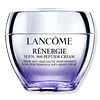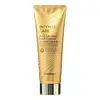What's inside
What's inside
 Key Ingredients
Key Ingredients

 Benefits
Benefits

 Concerns
Concerns

 Ingredients Side-by-side
Ingredients Side-by-side

Water
Skin ConditioningGlycerin
HumectantDimethicone
EmollientCetearyl Alcohol
EmollientTheobroma Grandiflorum Seed Butter
Skin ConditioningAlcohol Denat.
AntimicrobialCetearyl Isononanoate
EmollientNiacinamide
SmoothingGlyceryl Stearate
EmollientPEG-100 Stearate
Isopropyl Palmitate
EmollientOctyldodecanol
EmollientCyclodextrin
AbsorbentHydrolyzed Lupine Protein
Skin ConditioningPisum Sativum Extract
Skin ConditioningAdenosine
Skin ConditioningCapryloyl Salicylic Acid
ExfoliatingHydrolyzed Hyaluronic Acid
HumectantHydrolyzed Linseed Extract
Skin ConditioningPentaerythrityl Tetra-Di-T-Butyl Hydroxyhydrocinnamate
AntioxidantTrisodium Ethylenediamine Disuccinate
Tocopheryl Acetate
AntioxidantCera Alba
EmollientOrbignya Oleifera Seed Oil
EmollientSimmondsia Chinensis Butter
Skin ConditioningCetearyl Glucoside
EmulsifyingCitric Acid
BufferingHydroxyethyl Acrylate/Sodium Acryloyldimethyl Taurate Copolymer
Emulsion StabilisingPolysorbate 60
EmulsifyingPotassium Cetyl Phosphate
EmulsifyingSorbitan Isostearate
EmulsifyingTocopherol
AntioxidantDimethicone/Polyglycerin-3 Crosspolymer
CleansingBenzyl Alcohol
PerfumingGeraniol
PerfumingLimonene
PerfumingChlorphenesin
AntimicrobialDipropylene Glycol
HumectantPhenoxyethanol
PreservativeSodium Benzoate
MaskingParfum
MaskingWater, Glycerin, Dimethicone, Cetearyl Alcohol, Theobroma Grandiflorum Seed Butter, Alcohol Denat., Cetearyl Isononanoate, Niacinamide, Glyceryl Stearate, PEG-100 Stearate, Isopropyl Palmitate, Octyldodecanol, Cyclodextrin, Hydrolyzed Lupine Protein, Pisum Sativum Extract, Adenosine, Capryloyl Salicylic Acid, Hydrolyzed Hyaluronic Acid, Hydrolyzed Linseed Extract, Pentaerythrityl Tetra-Di-T-Butyl Hydroxyhydrocinnamate, Trisodium Ethylenediamine Disuccinate, Tocopheryl Acetate, Cera Alba, Orbignya Oleifera Seed Oil, Simmondsia Chinensis Butter, Cetearyl Glucoside, Citric Acid, Hydroxyethyl Acrylate/Sodium Acryloyldimethyl Taurate Copolymer, Polysorbate 60, Potassium Cetyl Phosphate, Sorbitan Isostearate, Tocopherol, Dimethicone/Polyglycerin-3 Crosspolymer, Benzyl Alcohol, Geraniol, Limonene, Chlorphenesin, Dipropylene Glycol, Phenoxyethanol, Sodium Benzoate, Parfum
Water
Skin ConditioningMyristic Acid
CleansingGlycerin
HumectantSnail Secretion Filtrate
Skin ConditioningPotassium Hydroxide
BufferingLauric Acid
CleansingLauramide DEA
Beeswax
Emulsion StabilisingStearic Acid
CleansingCocamidopropyl Betaine
CleansingGlyceryl Stearate
EmollientPEG-200
HumectantTrihydroxystearin
Skin ConditioningGlycol Distearate
EmollientPolysorbate 20
EmulsifyingPolyquaternium-7
PEG-100 Stearate
Gold
Cosmetic ColorantCitrus Limon Peel Oil
MaskingCitrus Aurantium Dulcis Peel Oil
MaskingCitrus Aurantium Bergamia Fruit Oil
MaskingCitrus Aurantifolia Oil
CleansingPinus Sylvestris Leaf Oil
MaskingEucalyptus Globulus Leaf Oil
PerfumingColloidal Gold
AntimicrobialAcetyl Heptapeptide-9
Skin ConditioningSh-Oligopeptide-2
Skin ConditioningVolcanic Ash Extract
Skin ConditioningPanax Ginseng Callus Culture Extract
Skin ConditioningNelumbo Nucifera Leaf Extract
Skin ConditioningSasa Quelpaertensis Extract
Skin ConditioningViscum Album Extract
Skin ConditioningMorus Bombycis Leaf Extract
SmoothingArtemisia Vulgaris Extract
Skin ConditioningOpuntia Coccinellifera Fruit Extract
Skin ConditioningCitrus Unshiu Fruit Extract
AntioxidantSaccharomyces Ferment
Skin ConditioningCamellia Sinensis Leaf Extract
AntimicrobialCentella Asiatica Extract
CleansingSoleirolia Soleirolii Extract
AntioxidantPropolis Extract
Skin ConditioningCoptis Chinensis Root Extract
AntioxidantZanthoxylum Piperitum Fruit Extract
Skin ConditioningUsnea Barbata Extract
Pulsatilla Koreana Extract
Skin ConditioningGlutamic Acid
HumectantTitanium Dioxide
Cosmetic ColorantMica
Cosmetic Colorant1,2-Hexanediol
Skin ConditioningSodium Chloride
MaskingTocopheryl Acetate
AntioxidantPhenoxyethanol
PreservativeEthylhexylglycerin
Skin ConditioningTetrasodium EDTA
CI 77491
Cosmetic ColorantWater, Myristic Acid, Glycerin, Snail Secretion Filtrate, Potassium Hydroxide, Lauric Acid, Lauramide DEA, Beeswax, Stearic Acid, Cocamidopropyl Betaine, Glyceryl Stearate, PEG-200, Trihydroxystearin, Glycol Distearate, Polysorbate 20, Polyquaternium-7, PEG-100 Stearate, Gold, Citrus Limon Peel Oil, Citrus Aurantium Dulcis Peel Oil, Citrus Aurantium Bergamia Fruit Oil, Citrus Aurantifolia Oil, Pinus Sylvestris Leaf Oil, Eucalyptus Globulus Leaf Oil, Colloidal Gold, Acetyl Heptapeptide-9, Sh-Oligopeptide-2, Volcanic Ash Extract, Panax Ginseng Callus Culture Extract, Nelumbo Nucifera Leaf Extract, Sasa Quelpaertensis Extract, Viscum Album Extract, Morus Bombycis Leaf Extract, Artemisia Vulgaris Extract, Opuntia Coccinellifera Fruit Extract, Citrus Unshiu Fruit Extract, Saccharomyces Ferment, Camellia Sinensis Leaf Extract, Centella Asiatica Extract, Soleirolia Soleirolii Extract, Propolis Extract, Coptis Chinensis Root Extract, Zanthoxylum Piperitum Fruit Extract, Usnea Barbata Extract, Pulsatilla Koreana Extract, Glutamic Acid, Titanium Dioxide, Mica, 1,2-Hexanediol, Sodium Chloride, Tocopheryl Acetate, Phenoxyethanol, Ethylhexylglycerin, Tetrasodium EDTA, CI 77491
 Reviews
Reviews

Ingredients Explained
These ingredients are found in both products.
Ingredients higher up in an ingredient list are typically present in a larger amount.
Glycerin is already naturally found in your skin. It helps moisturize and protect your skin.
A study from 2016 found glycerin to be more effective as a humectant than AHAs and hyaluronic acid.
As a humectant, it helps the skin stay hydrated by pulling moisture to your skin. The low molecular weight of glycerin allows it to pull moisture into the deeper layers of your skin.
Hydrated skin improves your skin barrier; Your skin barrier helps protect against irritants and bacteria.
Glycerin has also been found to have antimicrobial and antiviral properties. Due to these properties, glycerin is often used in wound and burn treatments.
In cosmetics, glycerin is usually derived from plants such as soybean or palm. However, it can also be sourced from animals, such as tallow or animal fat.
This ingredient is organic, colorless, odorless, and non-toxic.
Glycerin is the name for this ingredient in American English. British English uses Glycerol/Glycerine.
Learn more about GlycerinGlyceryl Stearate is a mix of glycerin and stearic acid.
It is used to stabilize the mixing of water and oil ingredients. By preventing these ingredients from separating, it can help elongate shelf life. It can also help thicken the product's texture.
As an emollient, it helps soften skin and supports barrier-replenishing ingredients.
In cosmetics, Glyceryl Stearate is often made from vegetable oils or synthetically produced.
This ingredient may not be fungal-acne safe
Fun fact: The human body also creates Glyceryl Stearate naturally.
Learn more about Glyceryl StearatePeg-100 Stearate is an emollient and emulsifier. As an emollient, it helps keep skin soft by trapping moisture in. On the other hand, emulsifiers help prevent oil and water from separating in a product.
PEGS are a hydrophilic polyether compound . There are 100 ethylene oxide monomers in Peg-100 Stearate. Peg-100 Stearate is polyethylene glycol ester of stearic acid.
Phenoxyethanol is a preservative that has germicide, antimicrobial, and aromatic properties. Studies show that phenoxyethanol can prevent microbial growth. By itself, it has a scent that is similar to that of a rose.
It's often used in formulations along with Caprylyl Glycol to preserve the shelf life of products.
Tocopheryl Acetate is AKA Vitamin E. It is an antioxidant and protects your skin from free radicals. Free radicals damage the skin by breaking down collagen.
One study found using Tocopheryl Acetate with Vitamin C decreased the number of sunburned cells.
Tocopheryl Acetate is commonly found in both skincare and dietary supplements.
Learn more about Tocopheryl AcetateWater. It's the most common cosmetic ingredient of all. You'll usually see it at the top of ingredient lists, meaning that it makes up the largest part of the product.
So why is it so popular? Water most often acts as a solvent - this means that it helps dissolve other ingredients into the formulation.
You'll also recognize water as that liquid we all need to stay alive. If you see this, drink a glass of water. Stay hydrated!
Learn more about Water